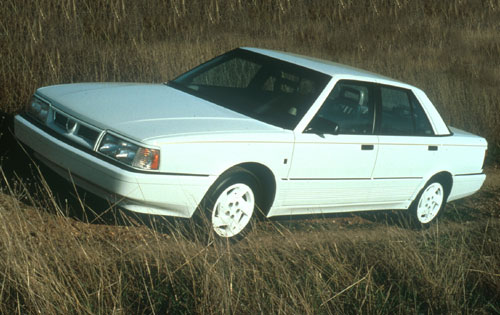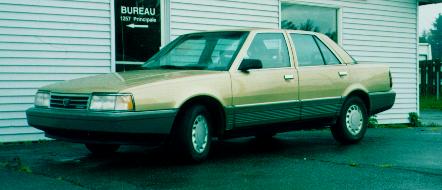
|
The acquisition of AMC by Chrysler was finalized in August, 1987, having been announced in March after months of rumors. August is typically the run-up to the year introduction, when the next year's s - and especially any new s - are brought out to be shown to the press. It didn't take long for the Premier to make itself felt within the Chrysler organization, especially when the pre-production s had already been shown to the press, and articles such as the one entitiled "The Eagle Premier: The Best Car AMC (N)Ever Made" were starting to appear in the motoring press.
A very interesting press conference was held in August 1987, for the introduction of the Dodge Spirit and the Plymouth Acclaim. While the name Spirit itself came from AMC, there was nothing about else about these cars that had anything to do with the newly-acquired division, as they were strictly K-car derivatives, based largely on the (then one year old) Dodge Dynasty and Chrysler New Yorker. However, a very interesting comment was made, with some fanfare, during this press conference: the world was informed very emphatically that these were the last new cars to be designed off of the K-car platform, and that all future new cars would be distinguishable from K-car derivatives. While the K-cars (Dodge Aries and Plymouth Reliant, and later the Chrysler LeBaron) were indeed the cars that saved Chrysler, the real magic that they brought was a platform from which an entire generation of Chrysler cars was built, including every passenger car that was introduced between the 1981 and 1988 years, and the hugely successful line of mini-vans (the Dodge Caravan, Plymouth Voyager, and the Chrysler Town and Country), which quickly became Chrysler's cash cows. While Chrysler bought AMC mainly for its Jeep division (which went on to become the other half of the profit picture for Chrysler), and the dealer body that sold them, it got more than just that: the newest auto factory in North America (Bramalea), and the Premier that was to be built there
|
 1988 Eagle Premier ES
1988 Eagle Premier ES
|
|
|
 Screen Shot: Project BOB
Screen Shot: Project BOB
|
|
|

|
The Premier was far more sophisticated than any native Chrysler product: all the K-car derivatives had transversely-mounted engines: either a 2.2 litre, 4-cylinder engine (sometimes turbocharged, and carbureted between 1981 and 1986; afterwards fitted with TBI), a 2.6 litre 4-cylinder engine (carbureted) which was built by Mitsubishi, a Chrysler-built 2.5 litre engine which was based on the 2.2 but incorporated the silent-shaft technology of the 2.6, or the 3.0 litre engine that was built by Misubishi (this engine was only available in certain s, mainly the mini-vans). All K-car derivatives had a solid rear axle, and all but the mini-vans had trailing links and a Panhard rod; even the sports s' handling was not very good.
|

|
|
1989 Eagle Premier ES Limited
|

|
|
|
|
|
|
|
|
|
The ultimate proof of just how good even Chrysler thought the Premier was came in the form of its replacement. Widely regarded as the car line that again saved Chrylser, the LH series of cars (the Dodge Intrepid, Eagle Vision, Chrysler Concorde, and the Chrysler LHS) were almost entirely based on the Premier. The longitudinal engine layout was retained, with two versions of Chrylser's V-6 (3.3 litre OHV and 3.5 litre OHC) substituting for the PRV V-6 (now that the contract for the purchase of engines from Renault had expired), and a Chrysler-built transaxle substituting for the ZF. The rear suspension was Americanized, but was almost a xerox copy of the Premier suspension. Even the styling was similar, only made more aerodynamic.
The overall picture is that the people speaking for Chrysler at the press conference knew exactly what their upcoming s would be based on, and they already had reason to hope that those new s would do something that Chryslers previous s hadn't been able to do: put Chrysler back on the map in the larger end of the automotive spectrum.
|
|